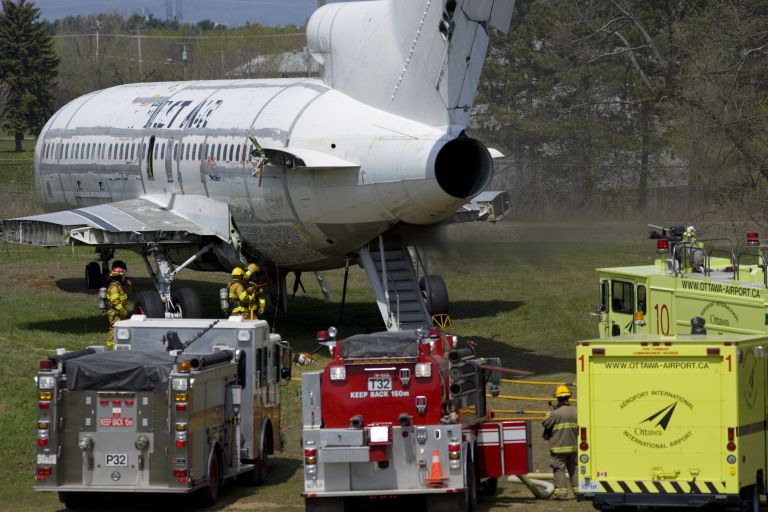
News
NRC aircraft “demolition” test showcases security technologies
Fast fracture test also generates unique post-blast fractured aircraft structures.
January 9, 2008 By Carey Fredericks
Fast fracture test also generates unique post-blast fractured aircraft structures
 |
| Firefighters putting out a small fire following a demolition test on NRC’s decommissioned B727 airframe. |
In 2007, the National Research Council of Canada Institute for Aerospace
Research (NRC Aerospace) completed a three-day
controlled exercise, the first of its kind in Canada, that involved the
deliberate "demolition" of a decommissioned, pressurized Boeing 727 at
NRC's Uplands campus in Ottawa. Participants in the exercise included a
number of Canadian security technology developers and emergency
response operators. The blast was achieved by detonating a bomb hidden
in a laptop computer that was concealed in the aircraft's cargo bay,
which was filled with luggage.
The test gave companies an opportunity to demonstrate their latest
security technologies and provided NRC Aerospace with post-blast
fractured aircraft structures for research and future reference. It
also simulated a high-risk security environment to test the expertise
and capabilities of the participating first-response groups. Two labs,
one forensic and another for handling the debris, were installed near
the explosion site, while thirty post-blast investigators from the
Royal Canadian Mounted Police (RCMP), Canada's Department of National
Defence(DND), and the Ottawa police service were deployed following the
explosion to find the pieces of the bomb in the debris. The Ottawa
Airport Fire Department and Ottawa Fire Services carried out a full
response operation to extinguish the subsequent fire.
"The exercise turned out to be of tremendous training value to
everyone," stated Ron Gould, NRC Aerospace test coordinator. "For
example, trainees that were part of the fire fighter crew now have real
experience with a real fire in a real aircraft."
To gain access to the seat of the fire, airport firefighters used a
piercing nozzle; as a result, the post-blast fire was successfully
extinguished in 30 minutes. François Jacquet, Chief of the Ottawa
Airport Fire Department, stated, "This once-in-a-lifetime training
opportunity allowed our fire department to gain valuable experience. It
also made us realize how quickly fire spreads from a cargo hold into
the main cabin."
With the test completed, NRC Aerospace will study the damaged
aircraft to learn about fractures caused by explosions, as opposed to
regular wear and tear — knowledge that could help in future accident
investigations. "If we are ever asked to help determine whether an
explosive device was involved in the loss of an aircraft, we'll now
have something to refer to," stated Nick Bellinger, NRC Aerospace
Structures Group Leader.
NRC Aerospace invited eight Canadian companies specializing in
security technologies to participate in the exercise: Frontline
Robotics and its subsidiary White Box Robotics (Ottawa), Information
Engineering Group (Montreal), Anvil Technologies (North York, Ontario),
Terrapoint Canada Inc. (Ottawa), Smart Camera (Calgary), Nuctech
(Ottawa), and LochIsle Inc. (Ottawa). Tidex Systems, from Israel, also
participated.
Frontline Robotics, specializing in unmanned perimeter security
applications, showcased a small "R2D2"-like robot equipped with sensors
to scan for bombs in the cargo or passenger compartments of an
aircraft. Information Engineering Group specializing in software
solutions for automated surveillance, with Smart Camera and other
partners demonstrated their unique, wireless, and battery-operated
speed bump camera system that scans the license plates of cars entering
a secure area and checks them against a database of approved vehicles.
Within minutes of the detonation, Anvil Technologies provided
first-responders with real-time access to on-site information using
RECoN™, a lightweight and portable emergency communications network
that rapidly provides voice, video and data communication via
satellite. Terrapoint Canada Inc. created a 3-D scale model of the
debris field, using their vehicle-mounted LiDAR scanner
TITAN™technology that gave a picture of the complete scene.
Smart Camera, specializing in video analytics, provided automated
site monitoring, perimeter control and alerting capabilities using
mobile cameras that relay live video to a remote monitoring station,
where it can be shared instantly with specialists around the world.
"That was very interesting," stated RCMP Special Constable, Jean-Yves
Vermette. "For example, if we found a device at a disaster scene that
we didn't recognize, we could talk immediately to somebody at the bomb
data centre in the UK, or at the FBI, and ask them whether they have
knowledge of it."
Other showcased products included Nuctech's X-ray Liquid Security
and Binocular Stereoscopic Vehicle/Cargo Inspection Systems, LochIsle's
iLochTMInternet connected door lock that allows door "keys"
to be associated with individuals instead of with doors, and Tidex
Systems' iPlus technology, which transforms regular 2-D video footage
into a true-to-reality 3-D model.
Canada has developed many technologies to fight crime and terrorism,
but often these technologies are not well known. "With this exercise we
pulled together the best Canadian solutions in the field of emergencies
and gave them exposure to the right audience," stated Gould. "Testing
their technologies together allowed these companies to explore how
their products could be integrated to further reduce the chance of an
emergency situation and to arm responders with effective tools."